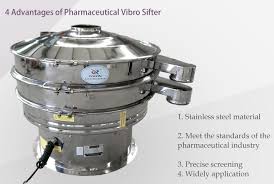High Capacity Vibratory Sifter: Detailed Overview, Advantages, and Applications

Introduction
The high capacity vibratory sifter is designed to meet the demands of industries requiring large-scale material processing. These sifters use vibration to effectively separate and classify substantial quantities of materials, ensuring efficiency and precision in high-volume operations. This article explores the functionality, benefits, and applications of high capacity vibratory sifters, providing insights into their role in enhancing productivity and operational efficiency.
What is a High Capacity Vibratory Sifter?
A high capacity vibratory sifter is a robust and advanced version of standard vibratory sifters, specifically engineered to handle larger volumes of material. It operates using vibrational force to move materials across a screen deck, allowing particles to be sorted based on size and other properties. The machine’s design and features are optimized to manage higher throughput, making it ideal for industries with significant processing needs.
Key Features of High Capacity Vibratory Sifters
- Large Screen Deck:
-
- Description: Features a larger screen deck area compared to standard sifters, designed to accommodate greater volumes of material.
- Function: Provides increased surface area for material separation, enhancing throughput and efficiency.
- Enhanced Vibrating Mechanism:
-
- Description: Equipped with advanced vibrating mechanisms such as powerful unbalanced motors or high-performance eccentric shafts.
- Function: Generates stronger and more consistent vibrations to facilitate effective material movement and separation.
- Heavy-Duty Frame:
-
- Description: Constructed from robust materials to support the increased load and operational stresses associated with high capacity processing.
- Function: Ensures stability and durability under demanding conditions.
- Advanced Control Systems:
-
- Description: Includes sophisticated control systems for adjusting vibration amplitude, frequency, and other parameters.
- Function: Allows precise control over the separation process, optimizing performance for different material types.
- Efficient Infeed and Discharge Ports:
-
- Description: Designed to handle high-volume material flow efficiently, with larger ports for smooth entry and exit.
- Function: Ensures effective management of material flow, reducing blockages and enhancing processing speed.
- Cleaning and Maintenance Features:
-
- Description: May include automated cleaning systems and easy-access components for maintenance.
- Function: Facilitates regular cleaning and upkeep, minimizing downtime and maintaining optimal performance.
Advantages of High Capacity Vibratory Sifters
- Increased Throughput:
-
- Benefit: Capable of processing large volumes of material in a single operation, improving productivity and efficiency.
- Enhanced Efficiency:
-
- Benefit: Optimized design and advanced features ensure effective separation and classification, reducing waste and improving product quality.
- Durability and Reliability:
-
- Benefit: Built to withstand rigorous operational conditions, providing long-term reliability and reducing maintenance needs.
- Customizable Performance:
-
- Benefit: Advanced control systems and customizable features allow for tailored performance based on specific material characteristics and processing requirements.
- Reduced Downtime:
-
- Benefit: Efficient cleaning and maintenance features minimize downtime, keeping operations running smoothly and reducing overall maintenance costs.
- Versatility:
-
- Benefit: Suitable for a wide range of materials and industries, making it a versatile choice for various high-volume applications.
Applications of High Capacity Vibratory Sifters
- Pharmaceutical Industry:
-
- Application: Used for high-volume separation and classification of powders and granules to ensure consistency and purity in pharmaceutical manufacturing.
- Food Processing:
-
- Application: Handles large quantities of food products and ingredients, ensuring the removal of contaminants and precise particle size separation.
- Chemical Industry:
-
- Application: Processes large volumes of chemical powders and granules, providing efficient separation and quality control.
- Mining and Aggregates:
-
- Application: Separates and classifies significant amounts of minerals, ores, and aggregates, improving material quality and processing efficiency.
- Recycling:
-
- Application: Sorts and classifies high volumes of recyclable materials such as metals, plastics, and paper, enhancing recycling operations.
- Construction:
-
- Application: Processes large quantities of sand, gravel, and other construction materials, meeting quality standards for concrete and asphalt production.
Selecting a High Capacity Vibratory Sifter
When choosing a high capacity vibratory sifter, consider the following factors:
- Material Characteristics:
-
- Consideration: Assess the properties of the materials to be processed, including particle size, density, and moisture content.
- Screen Size and Capacity:
-
- Consideration: Determine the required screen size and capacity based on the volume of material and the level of separation needed.
- Vibration Mechanism:
-
- Consideration: Choose a sifter with a robust and efficient vibrating mechanism to handle high throughput effectively.
- Customization Options:
-
- Consideration: Look for features that allow for customization, such as adjustable vibration settings and different screen configurations.
- Durability and Build Quality:
-
- Consideration: Ensure the sifter is constructed from high-quality materials and designed to withstand the demands of high-capacity operations.
- Cost vs. Value:
-
- Consideration: Evaluate the cost in relation to the features, performance, and potential return on investment.
Maintenance and Care
To ensure the optimal performance of a High Capacity Vibratory Sifter
Regular Inspections:
-
- Action: Conduct routine inspections for wear and damage to components, including the screen deck, vibrating mechanism, and frame.
- Cleaning:
-
- Action: Perform regular cleaning of the screen deck and other parts to prevent material buildup and maintain performance.
- Lubrication:
-
- Action: Ensure that moving parts are properly lubricated to minimize friction and wear.
- Adjustment and Calibration:
-
- Action: Periodically adjust screen tension, vibration settings, and other parameters to maintain optimal performance.
- Operator Training:
-
- Action: Train operators and maintenance personnel in proper handling and upkeep of the sifter.
Future Trends in High Capacity Vibratory Sifters
- Technological Advancements:
-
- Trend: Integration of advanced technologies such as automation, real-time monitoring, and predictive maintenance to enhance efficiency and performance.
- Customization and Flexibility:
-
- Trend: Growing demand for customizable solutions to address specific industry needs and material characteristics.
- Energy Efficiency:
-
- Trend: Development of energy-efficient designs to reduce operational costs and environmental impact.
- Sustainability:
-
- Trend: Focus on sustainable manufacturing practices and materials to meet environmental regulations and corporate sustainability goals.
- Enhanced User Experience:
-
- Trend: Innovations aimed at improving user interfaces and control systems for better ease of use and maintenance.
- Integration with Industry 4.0:
-
- Trend: Adoption of Industry 4.0 technologies for improved integration, automation, and data analytics.
Conclusion
High capacity vibratory sifters are indispensable in industries that require efficient and effective handling of large volumes of material. Understanding their key features, advantages, and applications helps businesses make informed decisions when selecting and maintaining this equipment. As technology advances, high capacity vibratory sifters will continue to evolve, offering enhanced performance, customization, and sustainability. Partnering with a reputable manufacturer ensures access to top-quality equipment and support, contributing to optimized material processing and operational success.





